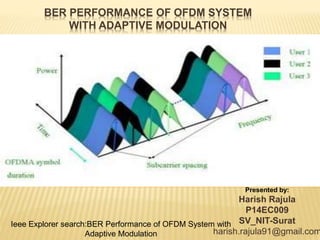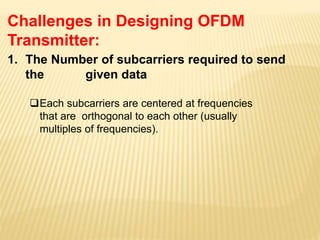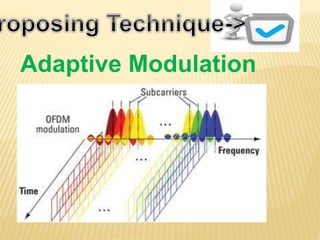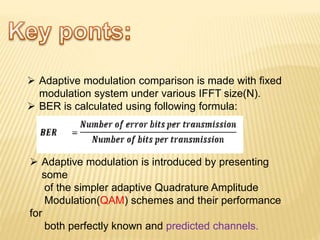Adaptive OFDM_Orthogonal Frequency Dvision Multiplexing_1
- 1. BER PERFORMANCE OF OFDM SYSTEM WITH ADAPTIVE MODULATION Presented by: Harish Rajula P14EC009 SV_NIT-Surat harish.rajula91@gmail.com Ieee Explorer search:BER Performance of OFDM System with Adaptive Modulation
- 2. Challenges in Designing OFDM Transmitter: 1. The Number of subcarriers required to send the given data ’ü▒Each subcarriers are centered at frequencies that are orthogonal to each other (usually multiples of frequencies).
- 3. 2. The second design parameter could be the Modulation format that we wish to use ’ü▒ An OFDM signal can be constructed using anyone of the following digital modulation techniques namely BPSK, QPSK, QAM etc..,
- 5. ’āś In an OFDM transmission system if the same fixed transmission scheme is used for all OFDM subcarriers, ’āś Each subcarrier is attenuated individually under the frequency-selective and fast fading channel ’āś It results in highest attenuation and hence poor performance
- 8. ’āś Adaptive modulation comparison is made with fixed modulation system under various IFFT size(N). ’āś BER is calculated using following formula: ’āś Adaptive modulation is introduced by presenting some of the simpler adaptive Quadrature Amplitude Modulation(QAM) schemes and their performance for both perfectly known and predicted channels.
- 12. Here IFFT size is denoted by N. For IFFT size N=64, 128, 256,512 ,1024,2048 BER performance has shown
- 13. ’āśIn adaptive modulation, modulation rate changes based upon value of an instantaneous SNR. ’āśThe BER performance comparison between fixed and adaptive modulation shows that BER performance for all modulation techniques is better, when IFFT size is greater than 512. ’āśFor all values of IFFT sizes, average BER of Adaptive modulation is approximately 0.203568 and for higher order fixed modulation it is approximately 0.913545 . ’āśHence, it concludes that BER performance of
- 14. ’āśEffect of Channel Prediction on Automatic Modulation Classification for Adaptive OFDM SystemsŌĆ” ’āś Adaptive OFDM for Wireless Interconnect in Confined EnclosuresŌĆ”..
Editor's Notes
- #9: both














